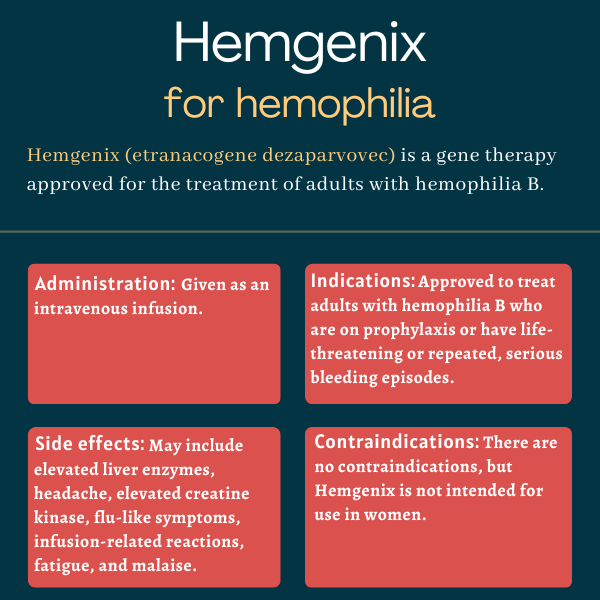Hemgenix (etranacogene dezaparvovec) for hemophilia
What is Hemgenix for hemophilia?
Hemgenix (etranacogene dezaparvovec), formerly known as AMT-061 and EtranaDez, is a gene therapy given as a one-time intravenous (into-the-vein) infusion to treat bleeding episodes in hemophilia B.
The therapy is indicated for adults who:
- are using clotting factor IX prophylaxis, or preventive treatment
- are experiencing or have a history of life-threatening bleeding episodes
- have repeated, serious bleeding episodes occurring spontaneously.
Hemgenix was developed by uniQure and licensed in 2021 to CSL Behring, which markets the therapy globally.
Therapy snapshot
| Brand name: | Hemgenix |
| Chemical name: | Etranacogene dezaparvovec |
| Usage: | Gene therapy to treat bleeding episodes in hemophilia B |
| Administration: | Intravenous infusion |
How does Hemgenix work?
Hemophilia B is caused by mutations in the F9 gene, which provides instructions for making clotting factor IX (FIX), a protein found in blood. When FIX is faulty or missing, the blood cannot clot properly to seal bleeding vessels. As a result, people with hemophilia B may experience heavy, longer-than-usual bleeding episodes that can be difficult to control.
Hemgenix works by delivering a working version of the F9 gene to liver cells. The working gene is packaged aboard a delivery vehicle called a vector. The vector used in Hemgenix is made from a virus called adeno-associated virus 5 (AAV5), which is harmless to humans.
Given as an infusion directly into the bloodstream, Hemgenix heads toward the liver. Once there, the working gene is unloaded from the AAV5 vector, and liver cells use its instructions to make FIX on their own. This is expected to increase FIX levels in blood and thereby help to prevent and control bleeding episodes.
The version of the F9 gene used in Hemgenix is called Padua and occurs naturally. It contains a single mutation that makes for FIX with clotting activity that is up to eight times greater than that of the wild-type (normal) protein. The therapy is expected to help keep bleeding in check over the long term.
Who can take Hemgenix?
The U.S. Food and Drug Administration (FDA) first approved Hemgenix in late 2022 to treat adults with hemophilia B who are on prophylaxis or have (or have had) life-threatening bleeding or repeated, serious bleeding episodes occurring spontaneously.
In early 2023, the European Commission gave Hemgenix conditional approval to treat adults with severe or moderately severe hemophilia B without a history of inhibitor (neutralizing) antibodies against FIX. Such antibodies may stop Hemgenix from working properly.
Who should not take Hemgenix?
There are no contraindications for Hemgenix, but patients are required to undergo testing to confirm they are eligible for the treatment.
The required tests are a screen for the presence of FIX inhibitor antibodies, a blood test to measure specific liver enzymes, and hepatic (liver) ultrasound and elastography, which is an imaging test to check the liver for stiffness. If patients test positive for FIX inhibitor antibodies in two tests taken two weeks apart, or if their liver is not healthy, they may not be eligible for Hemgenix.
The therapy is not intended for use in women.
How is Hemgenix administered?
Hemgenix is given as an intravenous infusion that usually lasts about 1 to 2 hours. How much is given depends on body weight.
It is available as a clear, colorless suspension supplied in single-use vials at a concentration of 10^13 (10 trillion) genome copies (gc) per milliliter (mL) and provided in kits containing 10 to 48 single-use vials. Each kit makes up a dosage unit based on body weight.
The recommended dose is 2 x 10^13 gc per kilogram (kg) of body weight infused at a constant rate of 500 mL per hour (8 mL per minute) after dilution with 0.9% sodium chloride solution (normal saline).
The infusion must be started under the supervision of a doctor experienced in hemophilia or other bleeding disorders, in a facility equipped to promptly treat infusion-related reactions if needed.
Once the infusion is complete, patients will be monitored for at least three hours to ensure they are ready to return home. Overall health, liver health, and FIX clotting activity will be tested weekly for the first three months to track a patient’s response to Hemgenix.
Patients can enroll in the Hemgenix Connect program, where they will be assigned to a dedicated support team. Its members will include a patient resource navigator and a CSL case manager, who both can assist with questions about the gene therapy, the treatment journey, and insurance coverage.
A mobile app called B Support is available for use with Hemgenix. Developed by BrightInsight, the app was launched in 2023 by CSL Behring to help patients transition from replacement therapy — a standard treatment for hemophilia — to gene therapy. Patients can use it to track the therapy they’re on, find out if they are eligible for Hemgenix, stay up to date on relevant information, and manage their treatment journey.

Hemgenix in clinical trials
Hemgenix’s approval was mainly supported by data from a Phase 3 trial called HOPE-B (NCT03569891), which evaluated the safety and efficacy of the therapy in men with moderate to severe hemophilia B.
Phase 2b clinical trial
A Phase 2b clinical trial (NCT03489291), which began dosing in 2018, tested the safety and efficacy of Hemgenix in three men with severe or moderately severe hemophilia B. All were given a one-time intravenous infusion of Hemgenix at the recommended dose.
FIX clotting activity increased from no greater than 1% to an average of 31% at six weeks after the infusion, reaching an average of 50% — near normal range — at 2.5 years (30 months). All three men stopped taking their routine prophylaxis. Two of them remained free of bleeding episodes, whereas the other one experienced one spontaneous and one traumatic bleeding episodes, each requiring a single dose of FIX replacement therapy.
At 2.5 years, two treatment-related side effects had been reported in one man; both resolved on their own. None of the three men had developed FIX inhibitor antibodies.
Safety continues to be monitored up to five years, with the clinical trial expected to conclude before the end of 2023.
Hope-B
The pivotal, ongoing open-label Phase 3 clinical trial HOPE-B is testing the safety and efficacy of Hemgenix at its recommended dose. The study involves 54 men, ages 19 to 75, with severe or moderately severe hemophilia B, in the U.S. and Europe.
Before they were given Hemgenix, all patients completed a six-month run-in period during which they continued to take their routine prophylaxis. Results at 18 months showed that Hemgenix outperformed the prophylaxis in reducing bleeding. The annualized bleeding rate decreased from 4.2 episodes per year during the run-in period to 1.5 during months 7 to 18 after infusion of Hemgenix.
FIX clotting activity increased to an average of 37% of normal levels at 18 months — an increase that was sustained for up to two years. All but three men (94%) stopped taking their FIX replacement therapy and no longer required prophylaxis.
At their entry to the clinical trial, 21 men tested positive for antibodies against AAV5, which may stop Hemgenix from working properly. All but one man with very high antibody levels responded well to Hemgenix, suggesting the therapy offers benefits regardless of the presence of antibodies against AAV5.
Hemgenix was generally safe, with no treatment-related serious side effects and no reported development of significant FIX inhibitor antibodies.
Both clinical trials nontheless were placed on hold by the FDA in late 2020 after one man, who was taking part in HOPE-B, developed hepatocellular carcinoma, a type of liver cancer. The hold was lifted about five months later following an independent investigation that showed it was very unlikely that Hemgenix had contributed to the development of hepatocellular carcinoma.
HOPE-B is ongoing and expected to conclude in March 2025.
Common side effects of Hemgenix
The most common side effects reported with Hemgenix during clinical trials were:
- elevated liver enzymes, a sign that the liver may be damaged
- headache
- elevated creatine kinase in blood, a sign that muscle tissues may be damaged
- flu-like symptoms
- infusion-related reactions
- fatigue
- malaise.
Infusion-related reactions
An infusion-related reaction, including anaphylaxis — a severe, whole-body allergic reaction — may occur during or after infusion of Hemgenix. Symptoms may include chest tightness, headache, abdominal (belly) pain, lightheadedness, flu-like symptoms, shivering, flushing, rash, and elevated blood pressure.
Patients will be monitored for at least three hours after the infusion is complete. If a reaction occurs, the infusion may be slowed or stopped, resuming at a slower rate once symptoms resolve. Treatment with a corticosteroid or an antihistamine may be required.
Liver toxicity
Hemgenix may lead to elevation of liver enzymes in blood, including transaminitis, or the elevation of transaminases. This is a sign that the liver may be damaged, which may reduce the therapeutic efficacy of Hemgenix.
Given that, testing is performed to check on liver health before Hemgenix can be infused. After the infusion, liver enzymes will be tested weekly for at least three months. If liver enzymes are higher than normal, patients will continue to be monitored until levels return to normal. Treatment with a corticosteroid may be required.
Liver cancer
Hemgenix unloads its genetic cargo into liver cells and it could possibly, in theory, insert into the DNA of liver cells or other body cells. While there is no evidence of this, Hemgenix could possibly contribute to a risk of cancer, such as hepatocellular carcinoma.
Therefore, patients who have a history of liver disease or those who drink alcohol excessively will be monitored regularly to check on liver health. They will be required to perform a hepatic ultrasound each year and be tested for elevated alpha-fetoprotein, a tumor marker, for at least five years after they are given Hemgenix.
Development of antibodies
The body may form inhibitor antibodies against FIX. If this happens, it may stop Hemgenix from working properly. If the expected levels of FIX activity are not reached, or if bleeding is not controlled, a blood test may be done to check for the presence of inhibitor antibodies.
Use in pregnancy and breastfeeding
It is not known if Hemgenix is safe to use in pregnancy, or if it passes into breast milk and is safe for a breastfed infant. In a mouse study, Hemgenix did not influence the course of pregnancy or fetal weight. However, the therapy is not intended for use in women.
Hemophilia News Today is strictly a news and information website about the disease. It does not provide medical advice, diagnosis or treatment. This content is not intended to be a substitute for professional medical advice, diagnosis, or treatment. Always seek the advice of your physician or other qualified health provider with any questions you may have regarding a medical condition. Never disregard professional medical advice or delay in seeking it because of something you have read on this website.
Recent Posts
- Short workouts and patience are key to my exercise regimen
- FDA approves Beqvez gene therapy for adults with hemophilia B
- Looking back at how we got here reminds me of my family’s strength
- GeneVentiv receives $2.5M grant for hemophilia gene therapy
- Learning to embrace imperfection after 10 years with my husband
Related articles

 Fact-checked by
Fact-checked by 



